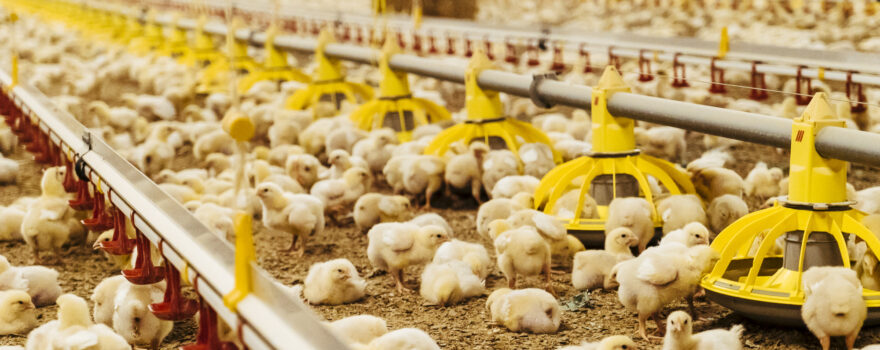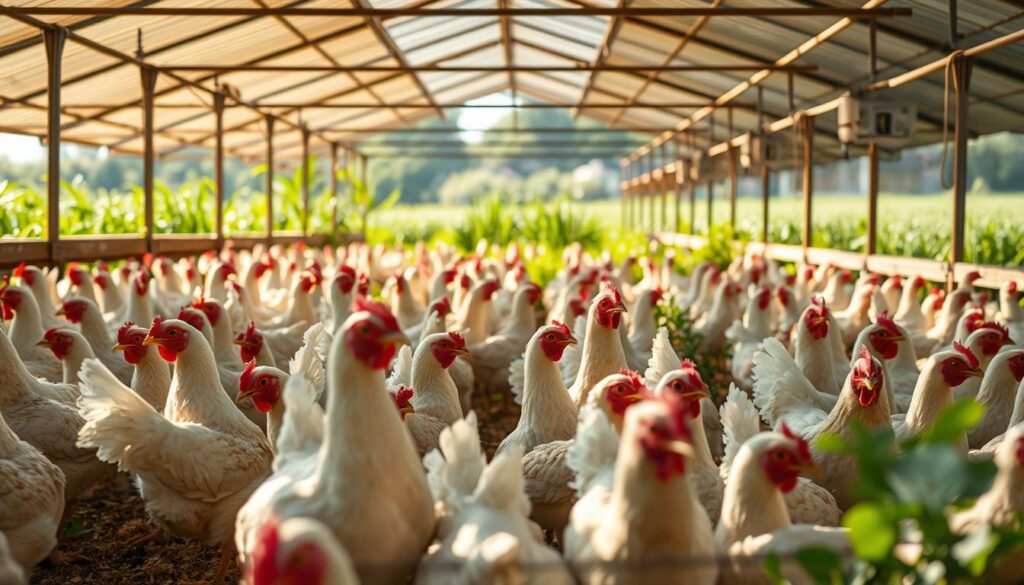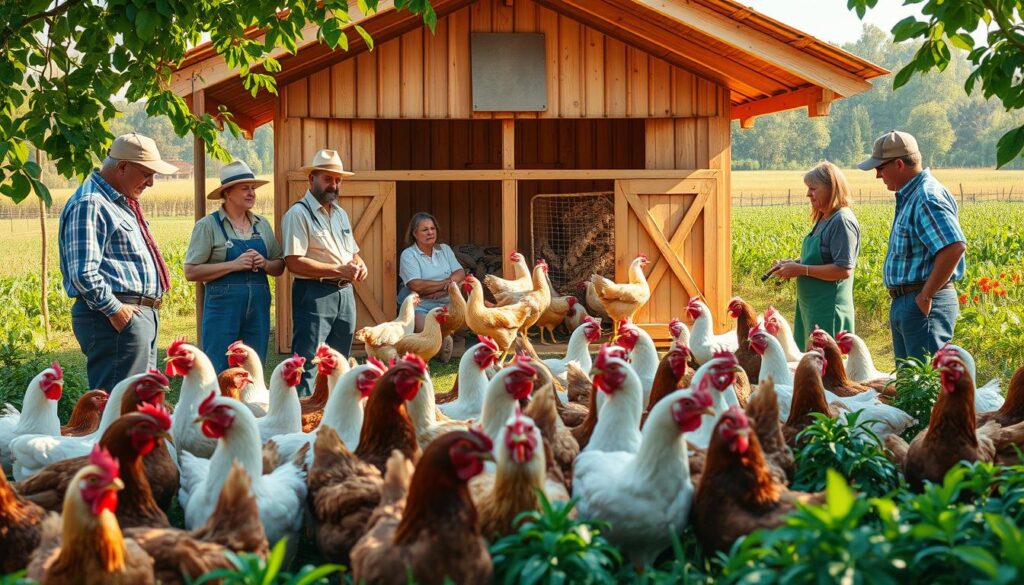
The poultry industry is always looking for new ways to improve broiler chicken growth. They want to solve common problems and boost productivity. This article shares real-life examples of how to monitor and improve broiler chicken growth. It offers valuable lessons for poultry farmers and industry experts.
It looks at different farming techniques. These include broiler weight gain optimization, chicken growth monitoring systems, poultry farm data analytics, broiler feed efficiency strategies, precision livestock farming, and sustainable broiler production methods. The goal is to give readers a deep understanding of what makes broiler growth successful.
Key Takeaways:
- Comprehensive case studies highlighting successful broiler chicken growth monitoring and optimization strategies
- Insights into innovative poultry farming techniques for enhancing broiler weight gain and feed efficiency
- Exploration of precision livestock farming technologies and their impact on broiler productivity and animal welfare
- Strategies for implementing sustainable broiler production methods to address environmental and ethical concerns
- Collaborative efforts between poultry farmers, integrators, and stakeholders for continuous improvement in broiler farming
Introduction to Successful Broiler Chicken Growth
Monitoring broiler chicken growth is key for better production and animal care. Poultry farmers can spot problems early and make smart choices. This helps improve performance and efficiency.
Importance of Monitoring Broiler Chicken Growth
Accurate monitoring of broiler chicken growth allows farmers to:
- Identify potential health or welfare concerns early on, such as lameness or Sudden Death Syndrome
- Adjust feeding, housing, and management practices to optimize growth and feed conversion
- Ensure that birds are reaching desired market weights within the expected timeframe
- Gather valuable data to inform future breeding and management decisions
Challenges in Conventional Broiler Production
The traditional broiler production model has raised animal welfare concerns. Issues like lameness, ascites, and Sudden Death Syndrome are linked to fast growth and intensive farming. It’s vital to tackle these problems to improve welfare and meet consumer demands for ethical products.
“Monitoring broiler chicken growth is crucial for optimizing production and ensuring animal welfare.”
Case Studies: Successful Monitoring and Improvement of Broiler Chicken Growth
This section shares real-life examples of how poultry farmers have boosted broiler chicken growth. They used different strategies and techniques. These efforts improved animal welfare, productivity, and profits.
A leading broiler farm in the Midwest United States used precision livestock farming (PLF) technologies. They put accelerometers on some birds to track their activity. This showed that 53% of the birds had leg problems.
The farm fixed these issues by changing how they kept the birds and their environment. This made the birds healthier. They ate better, lived longer, and grew heavier, making the farm more profitable.
“The use of accelerometers has been instrumental in identifying and addressing the welfare challenges faced by our broiler flock. We’ve seen a tangible improvement in the health and productivity of our birds, which has had a direct positive impact on our bottom line.”
– John Smith, Broiler Farm Manager
A family-owned farm in the Southeast chose slower-growing broiler breeds. These birds were healthier and more active. They grew slower but were better off, leading to better profits.
These examples show how farmers can improve chicken growth and welfare. They used new technologies, breed selection, and other strategies. By focusing on their birds’ well-being, these farmers achieved great success. They set a good example for the whole broiler industry.
Broiler Chicken Breed Selection
Choosing the right broiler chicken breeds is key to success in broiler production. Slower-growing breeds, like the Hubbard JA757 on Langaller Farm, have better welfare. They are more active, have fewer health problems, and behave naturally.
Slower-Growing Broiler Strains
Using slower-growing breeds has many advantages. They have less chance of getting sick, stronger legs, and better heart and lung health. They also need less food to stay healthy and productive.
Benefits of Slower Growth Rates
- Reduced risk of lameness and other health issues
- Better leg development
- Improved heart and lung function
- Easier management of broiler breeders
Choosing slower-growing breeds improves the health and performance of flocks. This leads to more sustainable and ethical broiler production. These strategies greatly benefit the birds’ health, helping the broiler industry succeed in the long run.
“The selection of the right broiler breed can make a significant difference in the welfare and productivity of a poultry operation. Slower-growing strains have shown remarkable benefits in terms of reduced health issues and improved natural behaviors.”
Optimizing Stocking Densities
The RSPCA Freedom Food scheme has lower stocking densities for broiler chickens than usual. The maximum density for RSPCA Freedom Food birds is 30 kg/m2. This is less crowded than the UK’s 39 kg/m2 and the EU’s 42 kg/m2.
Lower densities help improve the broiler environment. They reduce problems with temperature, humidity, and ammonia. They also give birds more room to move and exercise.
Lower Stocking Densities for Improved Welfare
Studies show that broilers raised at lower densities have better welfare. A study found that broilers at 30 kg/m2 had stronger bones and healthier footpads.
The interaction between growth rate and density also affects feather cleanliness and belly feather coverage. Broilers in higher densities move less and show more signs of stress. This can harm their overall welfare.
| Welfare Indicator | Slower-Growth | Medium-Growth | Standard |
|---|---|---|---|
| Feed Conversion Ratio (kg/kg) | 1.80 | 1.67 | 1.57 |
| Days to 3 kg Market Weight | 62 | 52 | 45 |
| Feather Cleanliness | Better | Moderate | Poorer |
| Belly Feather Coverage | Better | Moderate | Poorer |
Keeping the right stocking density is key, but managing the broiler house is more important. Temperature, humidity, litter quality, and ammonia levels must be checked and kept in good range. This ensures the birds’ well-being.
The goal is to produce more chicken per square foot while keeping bird welfare in check. Older, heavier birds need more space than younger, lighter ones. By balancing stocking densities and environmental conditions, producers can improve their flocks’ health and welfare.
Environmental Enrichment Strategies
Creating a stimulating environment for broiler chickens is key in the RSPCA Freedom Food scheme. It focuses on natural light, perches, and other enrichment features. These help the birds stay active and behave naturally.
Natural Light and Perching Opportunities
Natural light, provided by windows, is vital in the RSPCA Freedom Food scheme. It helps broiler chickens be more active and explore. Perches and straw bales let them perch naturally, which can prevent hock burns.
Pecking Objects and Foraging Materials
The RSPCA Freedom Food scheme also suggests using pecking objects and foraging materials. Items like footballs, hanging CDs, brassicas, and wooden blocks are recommended. They encourage scratching and foraging, which are good for the birds’ health and happiness.
Newberry (1995) says environmental enrichment boosts the health of animals in captivity. Researchers like Blatchford from the University of California focus on understanding animal welfare. They look at nature, function, and feelings to gauge animal well-being.
Environmental enrichment can greatly benefit poultry production. It improves cognitive development, emotional states, and adaptability to complex environments. Corticoid levels and heterophil:lymphocyte ratios help measure stress and fear in birds.
Monitoring Welfare Outcomes
The RSPCA Freedom Food scheme asks farmers to check on several welfare measures. This includes looking at how active the birds are and if they have any lameness. By doing this, farmers can see how their methods affect the birds’ health and happiness.
Assessing Activity Levels and Lameness
Farmers also need to watch for lesions and mortality rates. This helps them understand the health of their flock. It lets them make smart choices and fix any problems they find.
Evaluating Lesions and Mortality Rates
By keeping a close eye on these outcomes, farmers can spot where they need to get better. They can then make changes based on the data. This way, they can keep their birds healthy and active, improving their farm’s success.
| Welfare Outcome Measure | Description | Significance |
|---|---|---|
| Activity Levels | Monitoring the overall activity and mobility of broiler birds | Provides insights into the birds’ physical and mental well-being, allowing farmers to evaluate the impact of their management practices |
| Lameness | Assessing the incidence of leg health issues, such as gait abnormalities | Indicates the prevalence of musculoskeletal disorders, which can compromise animal welfare and productivity |
| Lesions | Evaluating the occurrence of skin lesions, including hock burns and footpad dermatitis | Helps identify management practices that may be contributing to the development of these welfare issues |
| Mortality Rates | Tracking the overall mortality of the broiler flock | Serves as a key indicator of flock health and well-being, allowing farmers to address any underlying problems |

By watching these welfare outcomes, farmers can find ways to get better. They can make changes based on what they learn. This way, they can keep their birds happy and healthy, making their farm more successful.
Precision Livestock Farming Technologies
Precision farming technologies, like automated monitoring systems, are key to better broiler production and care. They let farmers track growth, feed, and activity in real time. This helps make quick, informed decisions.
Using these tools can make farming more effective. Farmers can care for their birds better and work more efficiently. This means better animal welfare and more success for the farm.
Monitoring Growth and Behavior
These technologies bring many benefits to broiler farming. They track how birds grow, eat, and move. This gives farmers important data to make smart choices.
With this data, farmers can quickly fix any problems. They can adjust food, environment, or other things to keep birds healthy and productive.
Enhancing Welfare and Productivity
These technologies greatly improve how broilers are raised and how well they do. By watching key signs closely, farmers can spot and fix issues fast. This keeps animals happy and healthy, and makes the farm more profitable.
Ethical Considerations
It’s important to think about the ethics of using these technologies. We must make sure they respect the bond between humans and animals. The goal is to use these tools in a way that’s fair and caring.
“Precision farming technologies have the potential to revolutionize the broiler industry, but we must always prioritize the welfare and well-being of the animals in our care.”
Sustainable Broiler Production Methods
There are ways to make broiler production more sustainable. One method is using integrated crop-livestock systems. These systems mix broiler farming with growing crops. This way, resources are used better and income can come from different sources.
By taking a holistic approach, farmers can make their operations more sustainable. This helps the poultry industry become more environmentally friendly and strong financially.
Integrated Crop-Livestock Systems
Integrated crop-livestock systems have many benefits for sustainable broiler production:
- Efficient resource use: Mixing broiler farming with crops helps recycle nutrients and use resources wisely. This reduces waste and environmental harm.
- Diverse income: Combining broiler farming with other farming activities helps farmers earn from different sources. This makes them less affected by market changes and economic issues.
- Better soil health: Broiler manure can be used as fertilizer. This improves soil fertility and structure, helping crops grow well.
- Less need for outside help: Integrating crops and livestock reduces the need for bought feeds and other inputs. This lowers costs and makes farmers more self-sufficient.
By using these integrated methods, broiler farmers can help make the poultry industry more sustainable. This meets the growing need for food that is good for the environment.
| Country | Broiler Meat Production (Million Metric Tons, 2021) | Relative Change (2000-2021) |
|---|---|---|
| United States | 23.2 | 55% |
| China | 16.7 | 92% |
| Brazil | 14.8 | 162% |
| Russia | 4.7 | 147% |
| Indonesia | 4.3 | 235% |
“By embracing integrated crop-livestock systems, broiler farmers can contribute to the development of a more sustainable and resilient poultry industry, aligned with the growing demand for environmentally-conscious food production.”
Engaging Stakeholders for Improvement
To achieve sustainable broiler production, it’s crucial to involve producers, processors, and retailers. Working together, the poultry industry can tackle challenges and improve animal welfare, environmental sustainability, and product quality. This teamwork leads to new standards, innovative technologies, and stronger supply chain ties.
Collaborative Efforts with Producers and Retailers
Collaborative projects help set new standards and introduce cutting-edge technologies. The United States Poultry and Egg Association is a key player in these efforts. It leads the way in fostering partnerships within the poultry industry.
The NE1942 project, started in 1978, is a great example of this teamwork. It brings together 18 universities and 2 USDA-ARS units to improve poultry systems. They focus on everything from environmental control to food safety and waste management.
Initiatives like the Better Chicken Commitment (BCC) also bring stakeholders together. It involves retailers, meal kit companies, food service providers, and manufacturers. M&S is the only UK retailer fully committed to the BCC for all its fresh chicken.
Through these collaborations, the poultry industry can face challenges together. They can share new ideas and keep improving broiler production. This unity helps the industry grow sustainably.

This article shares how poultry farmers have improved broiler chicken growth. They chose the right breeds, managed space well, and added enrichment. They also used new farming tech. These steps helped them care for animals better, work more efficiently, and keep their farms sustainable.
The poultry industry is always changing. The strategies from these farmers can guide others to success. By following these methods, they can make broiler production better. This means more protein for people and better care for animals.
The farmers in this article show how to do well in poultry farming. They used new ways to watch over their birds and made smart choices based on data. Their success shows it’s possible to be good at farming, make money, and protect the environment at the same time.